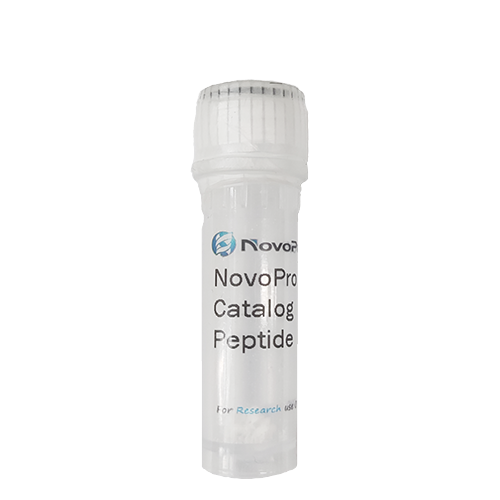KR-12 (human) peptide
Not For Human Use, Lab Use Only.
Cat.#: 304638
Special Price 140.90 USD
-
Product Name
KR-12 (human) peptide
-
Documents
Batch to batch variation of the purity
-
Sequence Shortening
KRIVQRIKDFLR-NH2
-
Sequence
H-Lys-Arg-Ile-Val-Gln-Arg-Ile-Lys-Asp-Phe-Leu-Arg-NH2
-
Length (aa)
12
-
Peptide Purity (HPLC)
99.81%
-
Molecular Formula
C71H127N25O15
-
Molecular Weight
1570.93
-
CAS No.
1218951-51-9
-
Source
Synthetic
-
Form
Powder
-
Description
KR-12 peptide is derived from the human antimicrobial peptide LL-37, and corresponds to its amino acid residues 18-29. It retains the antimicrobial activity of LL-37 while showing low toxicity to human cells, making it a potential candidate for various applications, especially in cosmetics.
KR-12 peptide has a nearly perfect amphipathic α -helical structure. This unique structure endows it with strong antimicrobial properties. It can effectively inhibit the growth of a wide range of bacteria and yeast. Its minimal inhibitory concentration (MIC) values against different strains are impressively low, much lower than those of common cosmetic preservatives like methylparaben and Scutellaria baicalensis extract. When incorporated into cosmetic formulations, KR-12 peptide exhibits excellent bactericidal effects. It can kill gram - negative Escherichia coli at concentrations starting from 25 μg/mL and gram - positive Staphylococcus aureus at 100 μg/mL, while conventional preservatives show no significant bactericidal activity even at higher concentrations.
Moreover, KR-12 peptide shows very low cytotoxicity to mammalian cells. In MTT assays with RAW264.7 cells, it demonstrated negligible toxicity even at relatively high concentrations. This makes it a safe and effective alternative to traditional cosmetic preservatives, offering a new solution for ensuring the stability of cosmetic products without causing harm to the human body. -
Storage Guidelines
Normally, this peptide will be delivered in lyophilized form and should be stored in a freezer at or below -20 °C. For more details, please refer to the manual: Handling and Storage of Synthetic Peptides
-
References
- Yun, H., Min, H.J. & Lee, C.W. NMR structure and bactericidal activity of KR-12 analog derived from human LL-37 as a potential cosmetic preservative. J Anal Sci Technol 11, 14 (2020). https://doi.org/10.1186/s40543-020-00213-x
- Kamysz E, Sikorska E, Jaśkiewicz M, Bauer M, Neubauer D, Bartoszewska S, Barańska-Rybak W, Kamysz W. Lipidated Analogs of the LL-37-Derived Peptide Fragment KR12-Structural Analysis, Surface-Active Properties and Antimicrobial Activity. Int J Mol Sci. 2020 Jan 30;21(3):887. doi: 10.3390/ijms21030887. PMID: 32019109; PMCID: PMC7036753.
- Jacob B, Park IS, Bang JK, Shin SY. Short KR-12 analogs designed from human cathelicidin LL-37 possessing both antimicrobial and antiendotoxic activities without mammalian cell toxicity. J Pept Sci. 2013 Nov;19(11):700-7. doi: 10.1002/psc.2552. Epub 2013 Sep 17. PMID: 24105706.
- Mishra B, Epand RF, Epand RM, Wang G. Structural location determines functional roles of the basic amino acids of KR-12, the smallest antimicrobial peptide from human cathelicidin LL-37. RSC Adv. 2013 Nov 14;(42):10.1039/C3RA42599A. doi: 10.1039/C3RA42599A. PMID: 24307932; PMCID: PMC3844289.
-
About TFA salt
Trifluoroacetic acid (TFA) is a common counterion from the purification process using High-Performance Liquid Chromatography (HPLC). The presence of TFA can affect the peptide's net weight, appearance, and solubility.
Impact on Net Weight: The TFA salt contributes to the total mass of the product. In most cases, the peptide content constitutes >80% of the total weight, with TFA accounting for the remainder.
Solubility: TFA salts generally enhance the solubility of peptides in aqueous solutions.
In Biological Assays: For most standard in vitro assays, the residual TFA levels do not cause interference. However, for highly sensitive cellular or biochemical studies, please be aware of its presence.
-
Molar Concentration Calculator
-
Dilution Calculator
-
Percent Concentration Calculator
Mass (g) = Concentration (mol/L) × Volume (L) × Molecular Weight (g/mol)
Related Products / Services
• Peptide Services: NovoPro's peptide synthesis services include standard chemical peptide synthesis, peptide modification, peptide libraries, and recombinant peptide expression.
• Standard Peptide Synthesis: NovoPro offers quality peptides at the most competitive prices in the industry, starting at $3.20 per amino acid. NovoPro provides PepBox – Automatic Quote Tool for online price calculation.
• Peptide Modifications: NovoPro offers a wide range of peptide modification services including isotope labeling (2H, 15N, and 13C), multiple disulfide bonds, multiple phosphorylations, KLH, BSA, ovalbumin, amidation, acetylation, biotin, FITC, etc.
Please note: All products are "FOR RESEARCH USE ONLY AND ARE NOT INTENDED FOR DIAGNOSTIC OR THERAPEUTIC USE"

